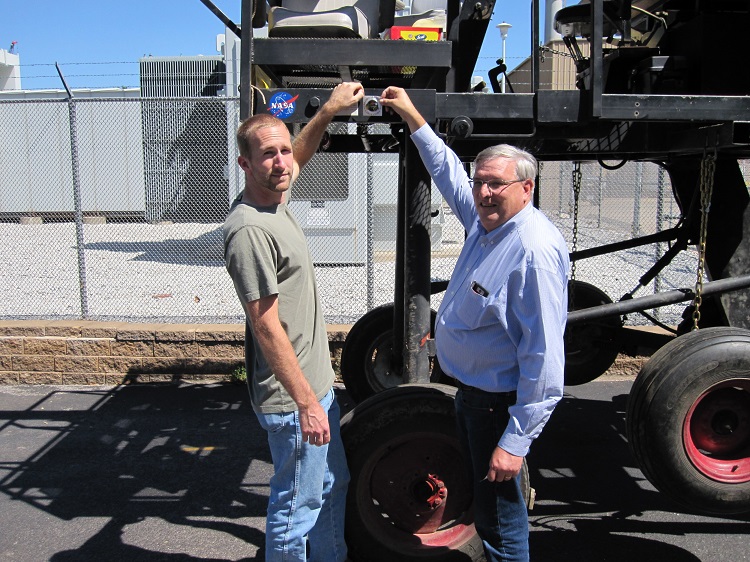
A corn detassler turned transportable remote sensing platform is ready for a second act.
Dubbed "Goliath," it belongs to the arsenal of remote sensing equipment at the Center for Land Management Information Technologies.
"CALMIT has had a long history of operating very stable and well-equipped mobile remote sensing platforms," said Art Zygielbaum, research associate professor.
Housed at the Agricultural Research and Development Center near Mead, Nebraska, these platforms are used to measure the spectrum of reflected light from above crop canopies.
Fourteen years of these measurements on primarily corn and soybeans have yielded spectral indices for estimating the concentration of pigments – such as chlorophyll and anthocyanin – in leaves.
"These indices, developed primarily by professor emeritus Anatoly Gitelson, are now in use worldwide for research and in agricultural applications," Zygielbaum said.
CALMIT's current platform, Hercules, is a large machine based on a prototype Hagee agricultural sprayer that cannot be readily transported to sites away from the ARDC.
Anticipating the need for a more transportable platform, Goliath – which had sat idle for several years – was selected for refurbishment.
Zygielbaum, along with research systems analyst Bryan Leavitt and graduate students Joe Lehnert and Trey Stafford, began the refurbishing process earlier this summer.
But breathing new life into Goliath would prove challenging.
"Having been mothballed for seven years, Goliath had vestiges of outmoded technologies, such as a 120-volt generator to run its data acquisition computer," Zygielbaum said.
Another obstacle was moving the platform itself.
Goliath was designed to be transportable by trailer. Moving Goliath – which weighs 19,000 pounds – requires a special vehicle trailer and a truck like those used in 18-wheelers.
"Whether pulling the oversized trailer, or moving the oversized machine onto and off of this trailer, it is difficult to work with unwieldy equipment of this size," Lehnert said. "We navigated these challenges through a little patience and a number of exaggerated hand gestures."
Due to the size and scope of this project, much of the reconstruction work took place in a building operated by the University of Nebraska Tractor Test Laboratory.
"We have the facilities here to support large equipment like Goliath so the unit was housed here over the summer while it was instrumented and prepared to return to the field," said NTTL director Roger Hoy. "Art and his team were wonderful people to work with."
The lab provided enough indoor space and access to a machine shop, both of which were essential for this project to succeed.
"The Tractor Test Lab was key to refurbishing Goliath," Zygielbaum said. "They have a cadre of talented staff able to answer questions and provide advice as we proceeded in the work."
As part of the refurbishment process, the team removed unnecessary mounting frames, designed and built a box to safely contain and operate new instruments, and outfitted the platform with a wireless communications system.
"Except for the fact that we are connecting the computer directly to the instruments rather than going through the Internet, the system is just like the one I use to read email on my laptop," Zygielbaum said.
This update will make Goliath a more effective remote sensing platform.
"I especially enjoyed working with Dr. Zygielbaum and Trey to help develop the new wireless spectrometer that will be mounted on Goliath," Lehnert said. "It's a system that should vastly improve the efficiency and reliability of data collection in the field."
Goliath was recently moved back to the ARDC, where it will be stored until it's called to action.
"In the coming year, it is expected that Goliath will be deployed to sites as far as Western Nebraska to aid in crop breeding experiments," Zygielbaum said.
— Mekita Rivas, Natural Resources